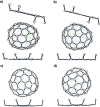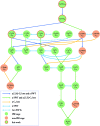Crystallographic identification of Eu@C2 n (2 n = 88, 86 and 84): completing a transformation map for existing metallofullerenes
- PMID: 30881639
- PMCID: PMC6385484
- DOI: 10.1039/c8sc04906h
Crystallographic identification of Eu@C2 n (2 n = 88, 86 and 84): completing a transformation map for existing metallofullerenes
Abstract
Revealing the transformation routes among existing fullerene isomers is key to understanding the formation mechanism of fullerenes which is still unclear now because of the absence of typical key links. Herein, we have crystallographically identified four new fullerene cages, namely, C 2(27)-C88, C 1(7)-C86, C 2(13)-C84 and C 2(11)-C84, in the form of Eu@C2n , which are important links to complete a transformation map that contains as many as 98% (176 compounds in total) of the reported metallofullerenes with clear cage structures (C2n , 2n = 86-74). Importantly, the mutual transformations between the metallofullerene isomers included in the map require only one or two well-established steps (Stone-Wales transformation and/or C2 insertion/extrusion). Moreover, structural analysis demonstrates that the unique C 2(27)-C88 cage may serve as a key point in the map and is directly transformable from a graphene fragment. Thus, our work provides important insights into the formation mechanism of fullerenes.
Figures






Similar articles
-
Crystallographic Characterization of U@C2n (2n = 82-86): Insights about Metal-Cage Interactions for Mono-metallofullerenes.J Am Chem Soc. 2021 Sep 22;143(37):15309-15318. doi: 10.1021/jacs.1c06833. Epub 2021 Sep 13. J Am Chem Soc. 2021. PMID: 34516733
-
Crystallographic characterization of Lu2C2n (2n = 76-90): cluster selection by cage size.Chem Sci. 2018 Oct 30;10(3):829-836. doi: 10.1039/c8sc03886d. eCollection 2019 Jan 21. Chem Sci. 2018. PMID: 30774877 Free PMC article.
-
Isolation and Crystallographic Characterization of Lu3 N@C2n (2n=80-88): Cage Selection by Cluster Size.Chemistry. 2018 Nov 7;24(62):16692-16698. doi: 10.1002/chem.201804651. Epub 2018 Oct 9. Chemistry. 2018. PMID: 30221415
-
Structural Studies of Giant Empty and Endohedral Fullerenes.Front Chem. 2020 Dec 3;8:607712. doi: 10.3389/fchem.2020.607712. eCollection 2020. Front Chem. 2020. PMID: 33344423 Free PMC article. Review.
-
Endohedral Metallofullerenes: New Structures and Unseen Phenomena.Chemistry. 2020 May 7;26(26):5748-5757. doi: 10.1002/chem.201905306. Epub 2020 Mar 13. Chemistry. 2020. PMID: 31886563 Review.
Cited by
-
Recent advances in endohedral metallofullerenes.Fundam Res. 2023 Dec 29;5(2):767-781. doi: 10.1016/j.fmre.2023.12.004. eCollection 2025 Mar. Fundam Res. 2023. PMID: 40242547 Free PMC article. Review.
-
Highly regioselective complexation of tungsten with Eu@C82/Eu@C84: interplay between endohedral and exohedral metallic units induced by electron transfer.Chem Sci. 2019 Apr 26;10(19):4945-4950. doi: 10.1039/c9sc01479a. eCollection 2019 May 21. Chem Sci. 2019. PMID: 31183042 Free PMC article.
References
-
- Kroto H. W., Heath J. R., Obrien S. C., Curl R. F., Smalley R. E. Nature. 1985;318:162–163.
-
- Kadish K. M. and Ruoff R., Fullerenes: Chemistry, Physics, and Technology, Wiley-VCH, New York, 2000.
-
- Fowler P. W. and Manolopoulos D. E., An Atlas of Fullerenes, Dover Publications, Clarendon, 2007.
-
- Popov A., Yang S., Dunsch L. Chem. Rev. 2013;113:5989–6113. - PubMed
-
- Lu X., Echegoyen L., Balch A. L., Nagase S. and Akasaka T., Endohedral Metallofullerenes: Basics and Applications, CRC Press, 2014.
LinkOut - more resources
Full Text Sources
Miscellaneous

